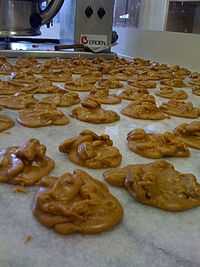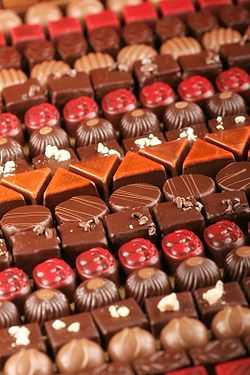Praline
| Praline | |
|---|---|
|
Belgian pralines | |
| Type | Confectionery |
| Place of origin | France |
| Main ingredients | Chocolate, nuts, syrup |
|
| |



Praline (US /ˈpreɪliːn/; UK /ˈprɑːliːn/). Two subvarieties of this confectionary exist:
- French pralines: a combination of almonds and caramelized sugar, harder than American praline.
- American pralines: a combination of syrup and pecans, hazlenuts or almonds with milk or cream, therefore softer and creamier, resembling fudge.
Two other uses exist:
- Praline cookie denotes a chocolate cookie containing ground nuts.
- Belgian pralines are at the most luxury end of Belgian chocolate and consist of a chocolate shell with a softer, sometimes liquid, filling, the most traditional filling of which is any one of a number of subtly different hazlenut, almonds, sugar, syrup and often milk-based pastes which with distinctive types of high-fat, low-melting point chocolate forms a main product of many Belgian chocolatiers.
Varieties
European nut pralines

As originally inspired in France at the Château of Vaux-le-Vicomte by the cook of the 17th-century sugar industrialist Marshal du Plessis-Praslin (1598–1675),[1] early pralines were whole almonds individually coated in caramelized sugar, as opposed to dark nougat, where a sheet of caramelized sugar covers many nuts.[2] Although the New World had been discovered and settled by this time, chocolate-producing cocoa (native to the New World) was originally not optionally associated with the term. The European chefs used local nuts such as almonds and hazelnuts.
The powder made by grinding up such caramel-coated nuts is called pralin, and is an ingredient in many cakes, pastries, and ice creams.[3] After this powder has been mixed with chocolate, it becomes praliné in French, which gave birth to what is known in French as chocolat praliné. The word praliné is used colloquially in France and Switzerland to refer to these, known simply as "chocolates" in English, i.e. various centres coated with chocolate.[4] In mainland Europe, the word praline is often used to mean either this nut powder or the chocolate paste made from it, widely used to fill chocolates, hence its use (by synecdoche) in Germany, the Netherlands, Belgium and the United Kingdom to refer to filled chocolates in general.[5] In the United Kingdom, the term can refer either to praline (the filling for chocolates) or, less commonly, to the original whole-nut pralines.
Belgian soft-centre pralines
Pralines from Belgium are also known as "(soft-center) Belgian chocolates", "Belgian chocolate fondants" and the somewhat vague "chocolate bonbons" in English-speaking countries — cases of chocolate (if from Belgium usually a quality, branded lower-melting point Belgian chocolate) filled with a soft centre. They were first introduced by Jean Neuhaus II, a Belgian chocolatier, in 1912.[6]
There have always been many types and shapes: nearly always containing a chocolate shell with a softer filling. Confusion can arise over the use of the word praline in Belgium as it may refer to filled chocolates in general known as pralines /prɑːliːn/ and it may also refer to a traditional praline filling common in Europe (caramelised hazelnuts (noisettes) or almonds (amandes) ground into a paste, sometimes with whey powder, condensed milk or cream) described as praliné /prɑːliːneɪ/. Belgian chocolates (pralines) are not limited to the traditional praliné filling and often include nuts, marzipan, salted caramel, coffee, a spirit, cream liqueur, cherry or a chocolate blend that contrasts with the outer shell. They are often sold in stylised boxes in the form of a gift box. The largest manufacturers are Neuhaus, Godiva, Leonidas, and Guylian.
American cream-based pralines
French settlers brought the recipe to Louisiana, where both sugar cane and pecan trees were plentiful. During the 19th century, New Orleans chefs substituted pecans for almonds, added cream to thicken the confection, and thus created what became known throughout the American South as the praline.
Pralines have a creamy consistency, similar to fudge. It is usually made by combining sugar (often brown), butter, and cream or buttermilk in a pot on medium-high heat, and stirring constantly, until most of the water has evaporated and it has reached a thick texture with a brown color. Then it is usually dropped by spoonfuls onto wax paper or a sheet of aluminum foil greased with butter, and left to cool. [2][7]
'Pralines and cream' is a common ice cream flavor in the United States and Canada.
See also
References
- ↑ Food Timeline Praline History
- ↑ 2.0 2.1 The Creole Confection – New Orleans Pralines
- ↑ Julia Child (1961), Mastering the Art of French Cooking, Alfred A. Knopf
- ↑ You Say Praline, I Say Praline, and They Say Praliné at the Wayback Machine (archived December 8, 2008)
- ↑ Belgian Pralines
- ↑ Amy M. Thomas (December 22, 2011). "Brussels: The Chocolate Trail". New York Times. Retrieved 2011-12-25.
Ever since the Brussels chocolatier Jean Neuhaus invented the praline 100 years ago, the city has been at the forefront of the chocolate business. ... They are breaking away from traditional pralines—which Belgians classify as any chocolate shell filled with a soft fondant center...
- ↑ Praline Definition
